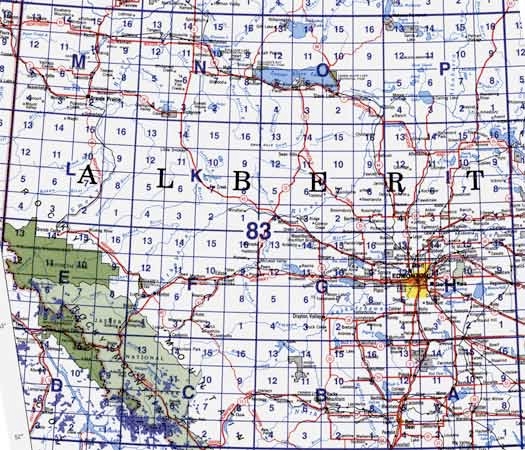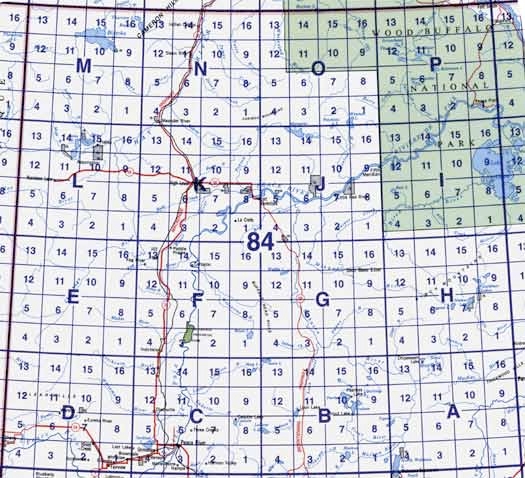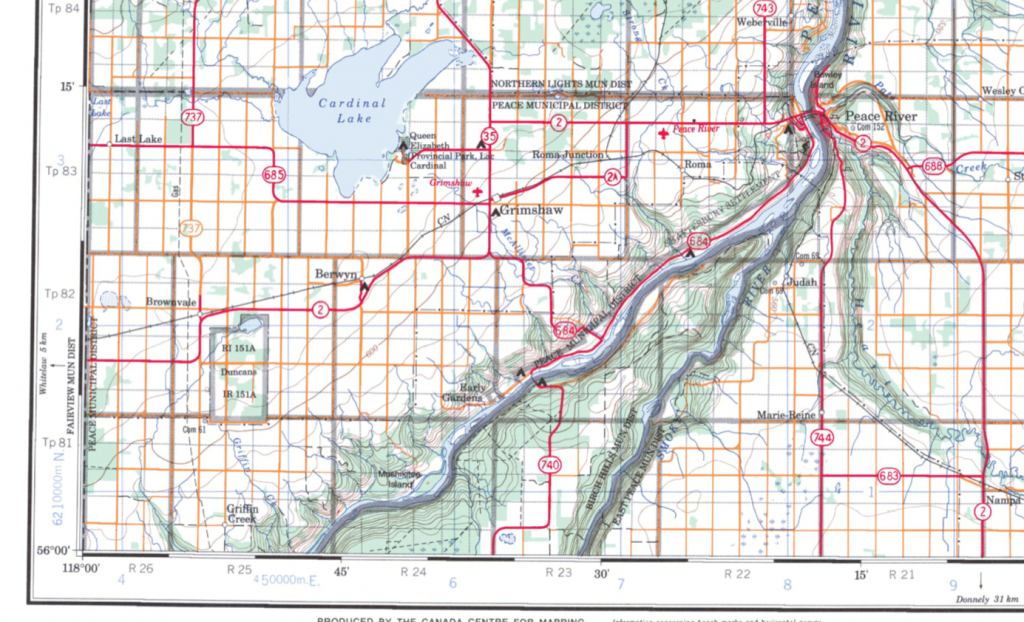I thought it might be useful to take some time to explain how maps work.
The Earth is divided into sections, using lines that run North-South and lines that run East-West. The size of each section depends on the scale, such as 1:250,000 or 1:50,000. The larger the second number in that ratio, the more “zoomed out” the map is. If you think about it, 1:1 would be a life size drawing, so the bigger the ratio, the more of “real life” is represented on the piece of paper that makes up the map.
These more-or-less rectangular sections are grouped into 4 x 4 grids. Canada is divided up into large numbered sections, with numbers increasing from East to West and North to South. For example, Saskatchewan is essentially 72, 73 and 74, Alberta is 82, 83 and 84, and BC is 92, 93 and 94, with the larger number being farther north. Within each, the land is further subdivided into 16 sections (in a 4 x 4 grid) and given letters as names. Again, each lettered sections at the scale of 1:250,000 are divided into 16 maps (4 x 4 grid) that are numbered.
See how “D C B A” goes across the bottom? Letter A is in the lower right corner of section 83 in the map above — the letters zig zag their way through the grid, from A to P. The numbering within each section, 1 to 16, is in the same manner.
So, now you can see how to track down which map you need for a given area. Look at this one:
See the Peace River squiggling its way from the lower left corner to the upper right? On this map, it comes on the scene in D4 as little blue line. Suppose, however, that you want to start your trip at Notikewin Provincial Park — that’s the green blob in section F which the river flows past. You will need to get maps for 84-F (1:250,000) or for more detail, F3 and F6 (1:50,000). I can give you a tip: for the Peace River, you don’t really need the 1:50,000 scale, which is a good thing, because if you did, you’d need a LOT of maps. The 1:250,000 scale work well enough. For the Hay or Chinchaga rivers, you’ll want the 1:50,000 scale. For my own use, I open the maps in my computer and crop out the parts I don’t need and then get them printed on 11″ x 17″ paper. They work great this way!
Now, to find a specific spot on the Earth, you need coordinates. Latitude and longitude is the old way of doing it, and the numbers increase from East – West and South – North. To remember how it works for longitude (East-West coordinate), a good way to think of it is that’s the direction that the sun moves across the Earth — it rises in the Maritime provinces before it gets to the prairies. As for latitude, the higher North you go, the bigger the number. You can use degrees, seconds and minutes, or simply decimal degrees (such as 54.43532 N) for both coords.
There is another coordinate system, however. In that one, called UTM (for Universal Transverse Mercator), the East-West coordinate increase is reversed; this one gets bigger from West to East, like when you read a book from left to right. The other coordinate still gets bigger as you go North. Here, the coords actually translate into metres on the Earth, and they are called “Northing” and “Easting.”
Look at a 1:250,000 topo map like the Canadian Government makes available (a portion above). The UTM coords are indicated in light blue letters and grid lines and the Latitude/Longitude is in black along the sides of the map. Lat and Long have no grid lines spanning the map.
The multitude of orange lines everywhere are gravel roads and they delineate sections, such as farmers use. The grey fat lines (and corresponding grey letters using R and Tp) indicate townships and sometimes county boundaries, but that’s a whole other geography lesson!
So, if you had to figure out where you were, you could read your coords off a GPS and then find them on the map by seeing where the two numbers cross. You might be thinking “but my GPS display will show me where I am.” That is true, however, when you are in the wilderness, you may find your GPS unit to be surprisingly non-useful — it will show you nothing if there are no roads or labelled features in its database. Wilderness = big empty space. This, of course, is not true! Wilderness = trees, creeks, wetlands, more trees, shrubs, hills, valleys, ponds, and so on.
Of course, the beauty of topo maps is seeing the slopes (topography). This gives you heads-up as to where the highest banks along the river will be, and where creeks flow in. Just a couple other notes: green areas are undeveloped (crown land) and designated parks. White land is, essentially, land that is owned by someone (farm land around here). Blue is obviously water, and marshy areas or wetlands have little, well, marshy symbols! Black dotted lines are usually cutlines and/or seismic lines, but can also be pipelines or quad/skidoo trails.
There is an abundance of information portrayed on a map once you know how to read it! Aren’t maps great!?
For more about the National Topographic System of Canada, go here.


